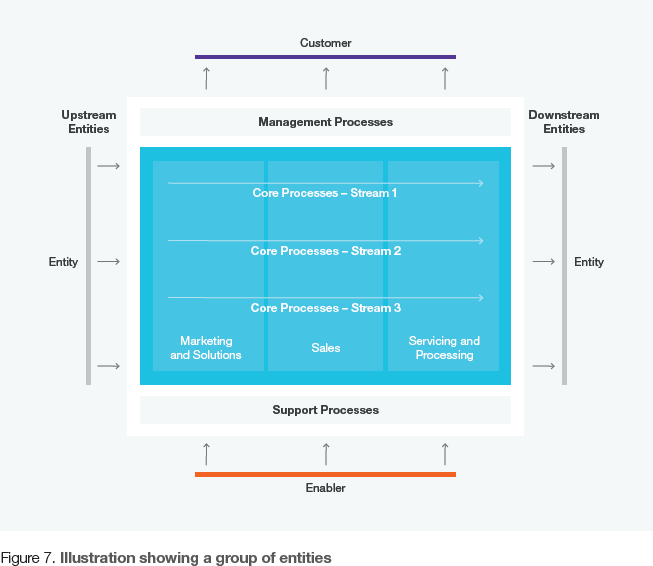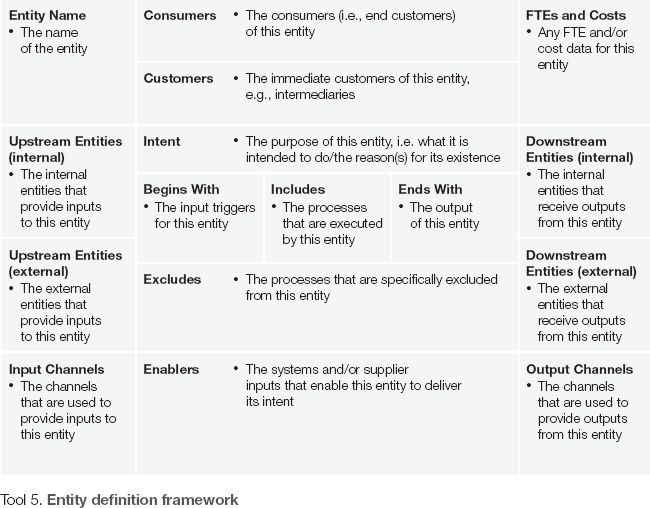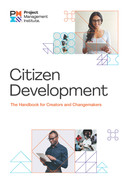| 3.1 Business Analysis and Design |  |
Apply the tools that trained operational consultants use to see the big picture.
A change in one part of an organization will have impacts elsewhere. Introducing a new application is no different; the intended changes may degrade or miss wider opportunities to make improvements across connected parts of the organization.
In this section you will find:
•A framework that process design experts use to visualize the organization's process architecture
•A framework for capturing the big-picture impact of creating an app and changing a business process; the entity definition provides a template to capture such big-picture impacts

“If you don't understand the details of your business, you are going to fail.”
Jeff Bezos
![]()
Overview
Having a model for conceptualizing the wider organizational impacts of creating applications will help citizen developers design better solutions. In doing so, these solutions are less likely to degrade other parts of the organization and will increase the potential to incorporate wider organizational improvements.
Citizen development empowers users to make improvements in an organization by creating solutions that solve the problems they see around them. Citizen developers work in all areas of an organization: sales, marketing, operations, finance, or logistics. Yet the solutions they design can and do have an impact on other parts of the organization. For instance, to make their work easier, a citizen developer may decide to create a solution that speeds up a process they control and perform daily. In doing so, they should consider the bigger picture: How does a change in one process area affect another upstream or downstream process?
This section outlines an approach for effectively considering the wider process architecture when designing solutions. It aims to raise awareness of the impact, both positive and negative, that a citizen development initiative can have on other parts of the organization.
Business Analysis and Design in Practice
Entity definitions
In some circumstances, creating a citizen development application can cause more problems than it solves. It could result in extra work for other departments if it replaces a tool that was used extensively by other areas of the organization. Taking the time to document an entity will ensure such impacts are considered.
An entity is a specific area of focus, usually an identifiable part of the organization, e.g., a business unit, function, department, or team. Figure 7 shows a high-level framework for how upstream and downstream entities interact with core processes within an organization.

The entity definition framework will help the user consider:
•Entities that are in scope
•Processes they execute
•Relationships with other entities
•Any dependencies that exist
•Resources and costs
•Value that the entities contribute
We provide a visualization on how to assess an individual entity in Tool 5.

With this framework in mind, here are some practical tips for conducting an assessment of the operating environment:
•Preparing entity definitions early when diagnosing a design initiative provides early insights into both the “big picture” and the “local” situation.
•An entity definition can be tweaked to highlight a specific characteristic, e.g., an upstream entity or intermediary.
•A series of one-page entity definitions can be displayed together on a wall to provide a visual reference, highlighting interactions, relationships, dependencies, options, “what if” scenarios, and so on.
•Entity definitions should be made visible to everyone involved in an initiative, and “ownership” of specific entities should be assigned to squad members.
Remember that an entity can be defined at many different levels—individual, team, department, business unit, and enterprise. However, the definitional framework remains the same, regardless of the level selected.
Entity definition framework case study: Streamline order-to-build process for a custom-built bike
Figure 8 represents an example of a real-life case study. In this situation, a company that manufactures custom bicycles was having trouble with their order specification sheet. The number of errors caused by the manual process was not sustainable.
Problem statement: People walking in the store would speak to the employee to submit a request for a fully customized bicycle. As the number of requests and the options to customize increased, handling the different orders led to many problems with specifications getting mixed up, resulting in some customers receiving a bike they did not order.
The solution: The entity is “online order process.” Customers fill out the specification sheets and send them to the manufacturer. Upstream from this, we can consider the sales and marketing departments. Downstream, we have manufacturing, product team, procurement, finance, customer service, etc.
Having created the entity definition for “bicycle orders,” it is now possible to analyze the interactions our application is going to have with upstream and downstream areas, teams, or departments. The procurement team can now integrate the app with their stock management app to show the in-store employees which parts are not available and thus extend the app to include stock management or consider integration through APIs into other application software.

Process architecture model
The process architecture model is a holistic and integrated framework that deconstructs an organization into process groupings that logically work together. There are many different model options that are in use today. For instance, Porter's Value Chain model is one of a number of alternatives to use. In Figure 8, we describe a simplified process architecture model that contains the key business processes that are universally relevant to both service and manufacturing organizations.
In Figure 9, we have divided the organization into three major layers:
•Management layer: Where coordination, oversight, and organizing of core processes occur
•Core process layer: Where goods and services are designed/improved, marketed, built, sold, and serviced
•Support layer: Also known as support services, where key support functions provide services to enable more efficient and effective function of the core process layer
Applying the process architecture model when designing a citizen development app enables the user to consider the processes that are impacted and the risks and process scope of the app.
The process architecture model (see Figure 9) provides a view of an organization's individual processes and the end-to-end processes crossing functional boundaries, providing a visualization at levels of detail that support process analysis and design, work instruction development, and requirements definition. It is a framework for looking at an organization as a logical set of connecting activities that flow across the organization and generate value for the customer.
Citizen developers who consider the changes they are designing in the context of the process architecture will be better able to consider stakeholders’ needs in the app. The value that the process architecture model provides to the citizen developer is a conceptual understanding of processes that the organization needs to manage, create, and support how goods and services are designed, built, and serviced throughout the organization. Having a framework will lead users to consider the wider, more strategic impact to the business apps they build.

The benefits of using a process architecture model include improved customer experience, improved operational efficiency, reduced process complexity, and improved quality of service.
